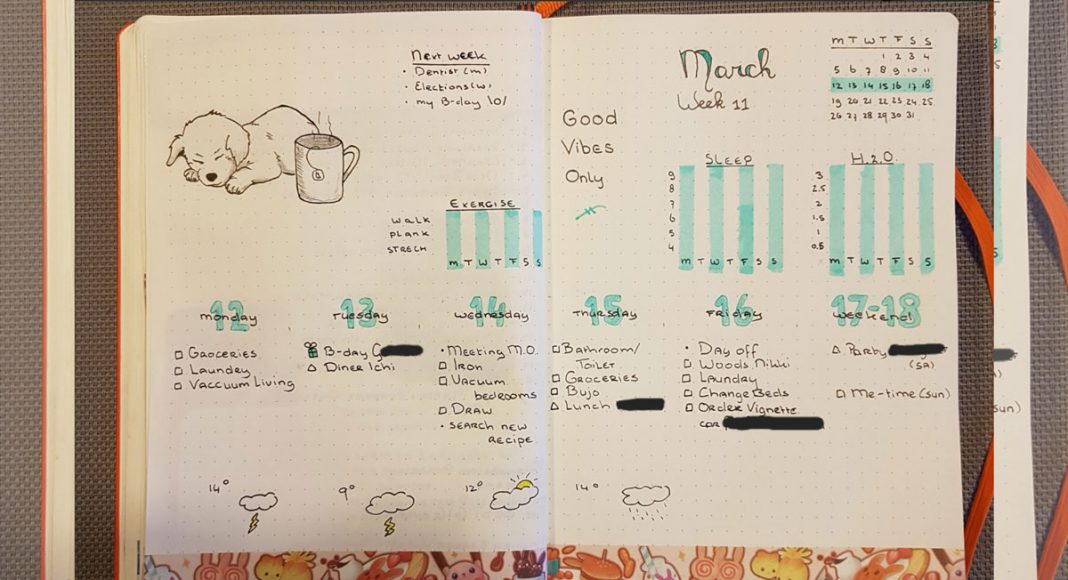If you were about to search the hashtag #bujo, what do you imagine would come up on your feed? A type of food? A place? It sounds like a sake brand, to be honest. But if you searched that tag, your eyes would be flooded with a sea of notebooks so colorful and well-designed that they border on being straight-up works of art. It is a new notebook, but what is a bullet journal?
They’re all the rage on social media right now (hence the #bujo hashtag that suddenly now makes a ton of sense.) It’s essentially a notebook that has been organized into a detailed diary-calendar-planner-Fitbit hybrid of sorts.
Week Ten #bulletjournal– what is the theme? I’m not sure, except I love all these colors. #bujo pic.twitter.com/z7104SAYB0
— Katie Diek (@KatieDiek) March 5, 2018
Bullet journals, like the name suggests, work like expeditious logging. People track their past, present, and future by writing down things like their feelings, goals, deadlines, reminders, appointments, habits, and anything else that you could record on a daily, weekly, and monthly basis (and in neatly spaced boxes). People often have an index page to decipher the different symbols, colors, and boxes used.
Turns out, bullet journals are ideal for those who procrastinate or lead busy lifestyles, a.k.a. most folks.
“It helps prompt and organize thoughts,” psychotherapist Kimberly Hershenson says. “Seeing your goals in concrete terms as well as tasks to get there will give you a plan to achieve your dreams.”
It’s true. To-do lists have been found to give people better feelings of structure and less feelings of chaos, according to the Guardian. But journaling past just errands and grocery lists can be incredibly beneficial as well. One 2001 study by Southern Methodist University of 81 undergraduate students found that writing down goals and thoughts, like their “most traumatic life event” and their “best possible future self,” did help more students feel happier and less stressed.
“It has really helped me to have my bujo because when thoughts are flying around in my head about things I can’t forget and things I need to do, I tend to become quite anxious and I always end up forgetting something, but to put it down on paper has helped me,” says photographer Georgia Penny, who has been bullet journaling since October 2016. She also says that she has tried regular planners and nothing really stuck.
Week 12 #bujo #bulletjournal pic.twitter.com/geUkEcmsnZ
— Hika (@Hikasawr) March 16, 2018
The super visual aspect of bullet journaling really does take it one step further. As Hershenson says, the layout of bullet journals help people notice trends, triggers, and other patterns, which in turn make it easier to make positive change. That’s one thing a normal diary or planner typically doesn’t display.
Blogger Kayla Arnold, who has been bullet journaling for almost a year now, can attest to this. Her habit tracker—or when you fill in a box at the end of each day if you give into a habit you’re trying to kick or gain—has been “super motivating for me because I want to see them all filled in.” Now she drinks more water, has become more of a morning person, and even adheres to her cleaning schedule.
-
Related Story: An Easy Way To Keep Track Of How Much Marijuana You Use
More than just motivating, having everything visually laid out can have a calming effect on people. “Think of how you feel coming home to a messy house versus an orderly house,” Hershenson adds. What a zen concept.
Creating and not just filling out the journal plays a part in its soothingness. Arnold looks forward to sitting down every Sunday night to plan out her week, a time she calls “relaxing.”
Weekly spread week 11 and needed some drawing practice so I combined those two #bujo #bulletjournal #artontwitter pic.twitter.com/MT6Qzfbc2O
— Faith (@faithfully_ever) March 10, 2018
Penny agrees, saying that creating her BuJo is “therapeutic.” Like with Arnold, Penny, who says she has no drawing skills, enjoys sitting down after a long day and creating her next monthly spread. “…If I’m having a bad day and haven’t been able to leave the house, it’s nice to feel like I’ve achieved or completed something, even if it’s just my BuJo.”
But creating such a colorful spread takes time. To prepare for each new month, it takes Arnold about an hour. To some, that sounds like a nightmarish 60 minutes of measuring out perfectly straight lines and even boxes.
According to Hershenson, Type A peeps will probably enjoy making such lists and charts. Creative types who think journaling can be an all-around chore can also find a way to make bullet journaling enjoyable. They can think outside the box, and adorn their journal with drawings or magazine cut-outs. (For instance, Penny uses her journal as a chance to practice calligraphy.)
In a way, that’s the best part about bullet journaling. You can personalize it to what you like and what works for you. Don’t like boxes? Draw circles or hearts. Don’t like writing vertically? Go horizontal. It’s not forcing yourself to fit into some app’s formula or planner’s design—it’s about fitting the design around your life. That’s a journal worth keeping.


